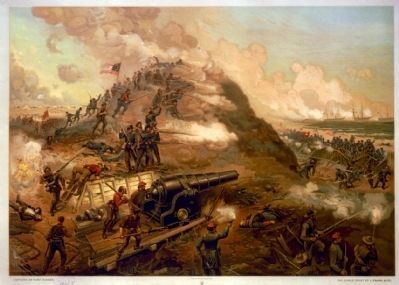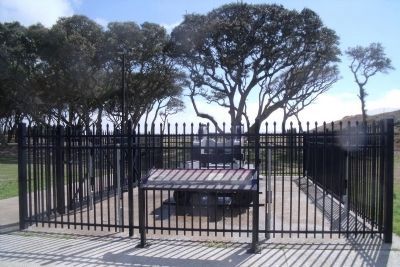Kure Beach in New Hanover County, North Carolina — The American South (South Atlantic)
A Trophy of War
After the fall of Fort Fisher, the Armstrong gun became a war trophy and the focus of photographs and newspaper articles. Union soldiers, such as Captain Trickey of the 3rd New Hampshire, noted the “elegantly mounted Armstrong gun … the carriage being of rosewood and mahogany.”
Shortly after the war the gun was taken to the U.S. Military Academy at West point. It was placed on trophy Point overlooking the Hudson River, where it has been a popular attraction ever since.
Erected by Fort Fisher Historic Site.
Topics. This historical marker is listed in these topic lists: Forts and Castles • War, US Civil.
Location. 33° 58.279′ N, 77° 55.082′ W. Marker is in Kure Beach, North Carolina, in New Hanover County. Marker can be reached from Fort Fisher Boulevard South (U.S. 421) near Battle Acre Road. This marker is located along the quarter-mile tour trail at Fort Fisher State Historic Site. Touch for map. Marker is at or near this postal address: 1610 Fort Fisher Boulevard South, Kure Beach NC 28449, United States of America. Touch for directions.
Other nearby markers. At least 8 other markers are within walking distance of this marker. Fort Fisher’s Armstrong Cannon (here, next to this marker); Blockade-Running (a few steps from this marker); History Trail (within shouting distance of this marker); Growth of Fort Fisher, 1861-1862 (within shouting distance of this marker); Fort Fisher Since 1865 (about 300 feet away, measured in a direct line); Fort Fisher (about 300 feet away); Lamb Expands the Fort, 1862-1865 (about 300 feet away); Capture! (about 400 feet away). Touch for a list and map of all markers in Kure Beach.
More about this marker. On the upper left is a newsmagazine with the caption, "The February 11, 1865, Harper’s Weekly confirms that the capture of the Armstrong was big news. The article reports that during the confusion attending the occupation of the works by Union troops some mischievous person stole the sights.”
On the lower left is a photo of Fort Fisher with the caption, "Federal troops looked on from Purdie Battery’s traverse as Timothy O’Sullivan photographed the Armstrong following the fall of the fort. (National Archives)"
On the bottom center is a print of the battle with the caption, "J.O. Davidson used O’Sullivan’s photograph of the captured Armstrong to create this imaginative scene. It depicts the naval assault on the
Northeast Bastion during the second battle of Fort Fisher. (N.C. Office of Archives and History)"
On the bottom center is a photo with the caption, "After the fall of Fort Fisher, Federal naval forces took possession of abandoned Confederate defenses protecting Old Inlet. At Fort Caswell, the U.S. Navy laid claim to the fortress’s 8 in. 150 lb. Armstrong. This sister gun to the Fort fisher Armstrong was transported to the Naval Academy at Annapolis (at left). The cannon was melted down as part of the nation’s patriotic scrap drive during World War II. (National Archives)"
On the upper right is a drawing of the gun with the caption, "The gun was “built up” by a series of concentric wrought-iron tubes made from spiral coils welded together under a steam hammer. The tubes, or hoops, were then shrunk over one another so the inner tube or barrel was in a state of compression and able to resist the force of explosion. Each tube was turned on a lathe to a slightly smaller diameter than the one it was to fit over. Then it was expanded by heating and dropped in place."
On the bottom center is a photo of a USCT soldier with the caption, "Many soldiers, both North and South, mentioned the impressive Armstrong in their correspondence. Sgt. Major Christian Fleetwood, a Medal of Honor recipient with the 4th U.S. Colored troops, wrote “One gun in particular, an Armstrong gun made in England, finished with mahogany, polished steel and brass mountings, was handsome enough for a piece of parlor furniture.” (U.S. Army Military History Institute)"
On the upper right is photo of West Point cadets with the caption, "Once the “Pride of Fort Fisher,” the Armstrong is now the “Pride of West Point” and mounted at the U.S. Military Academy’s Trophy point. It is a long-standing tradition for cadets and grduates to be photographed with this historic war trophy. (Left: Fort Fisher Files. Below: U.S. Army Military History Institute)"
Also see . . . Fort Fisher. North Carolina Historic Sites entry (Submitted on March 16, 2010, by Bernard Fisher of Richmond, Virginia.)
Credits. This page was last revised on August 18, 2021. It was originally submitted on March 16, 2010, by Bernard Fisher of Richmond, Virginia. This page has been viewed 949 times since then and 19 times this year. Photos: 1. submitted on March 16, 2010, by Bernard Fisher of Richmond, Virginia. 2. submitted on March 17, 2010, by Bernard Fisher of Richmond, Virginia. 3. submitted on March 16, 2010, by Bernard Fisher of Richmond, Virginia.


